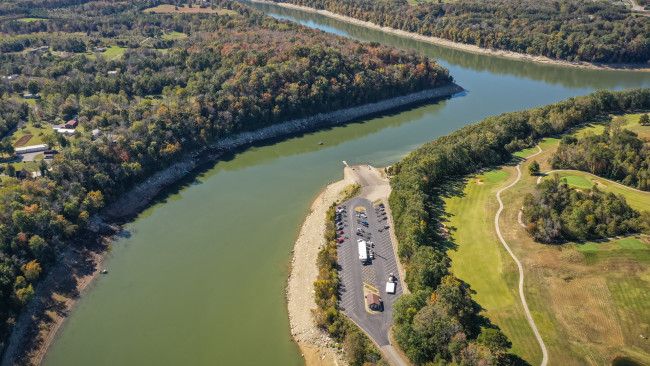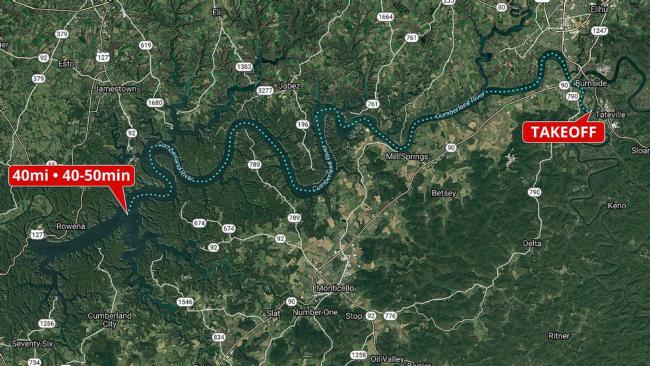The Layout of Lake Cumberland
Getting to know the site of the Costa FLW Series Championship

The ninth largest reservoir in the U.S., Lake Cumberland is a perfect stage for the Costa FLW Series Championship. Home to all three bass species and over 1000 miles of shoreline, the lake can swallow up a big field with relative ease, and with the fall bite starting to pick up in earnest and the water level lower than usual, the fishing should be pretty good.


Takeoff is up the river, at General Burnside Island State Park. In the spring, when the FLW Tour has stopped at Cumberland the run down to the lower end of the lake has been harrowing, with plenty of floating debris from rising spring water to navigate through. In the fall, that should be less of a problem, but it’d be no shock to see some fog in some portions of the lake.
No matter if it is fog or something else that slows the run, it’s a significant time commitment to run to the lower end of Cumberland. However, history shows that wins come from the lower end, so it’s likely that quite a few anglers will pin their ears back and make the run.

The upper end of the lake is more riverine and has dirtier water, and Nick Ratliff, who finished third in a T-H Marine Bass Fishing League (BFL) event on Cumberland this spring says that it’s the more reliable option for medium-sized fish, but doesn’t have the top end size in it to build a bag in the high teens. However, it’s close, should have plenty of fish and has produced a number of high finishes before.


The lower and mid-sections of Cumberland are where the party has gone down in major FLW events in years past, and there’s a good chance it happens again this time around.
“The last couple falls the lower end has been extremely tough, last year we were doing well in tournaments fishing 100 percent for spotted bass,” says Ratliff. “But because they’ve drawn the lake down so far this fall that has not been the case, the majority of the local tournaments with larger fields are taking 16 to 18 pounds to win, and for the most part that’s lower-end fish.”
The lower end of the lake is where the biggest smallmouths live and where the clearest water is, and it has everything the rest of the lake has.

Though there are differences between the upper and lower parts of Cumberland like most reservoirs, the lake has similar structure features throughout. It’s super rocky, with bluffs, steep banks, long creeks and fairly steep features. Unlike a lake like Dale Hollow, Douglas or Cherokee, which are similar in a lot of ways, Cumberland doesn’t have much offshore structure to speak of – it’s mostly very steep, and the fish that are off the bank feed on alewives and live a very pelagic lifestyle.

Cumberland also has a bunch of standing timber in the form of small trees from when the lake was drawn down to work on the dam. That cover has led to a boost in productivity in recent years, making this version of Cumberland much better than the one that hosted the FLW Series Championship won by Brent Ehrler back in 2004.
The standing trees are present through the lake, but most obvious in the backs of creeks and pockets where they grew thickest during the drawdown. A lot of the trees are out of the water now, but it’s still obviously very good cover, and what’s left will likely see quite a bit of pressure from anglers and give up quite a few fish.

The major storyline now is the water level – currently, the lake is lower than it has been since before 2014, and running at slightly lower, but comparable levels to the fall of 2016. That lower water has some thinking the fishing could be really good, like it was in the fall of 2016.
“I think it concentrates the baitfish and the fish,” says Ratliff. “Cumberland is so big, in the spring they want to be on the bank, but in the fall they can be wherever they want. If they’re chasing bait and they don’t have any reason to go to the bank then they’re hard to catch. It was awesome in the fall of ’16, you could put the trolling motor on 70 and go down the bank and have a blast.”
The lower water doesn’t just limit the options of roaming fish, it also takes acres of standing trees and laydowns out of the water, especially in the creeks.
“It concentrates some of the bank fish too, a lot of the lines of timber that are deeper when the water is high are in 4-10 foot of water now,” explains Ratliff. “The fish in that are just dumb, it’s like catching spring fish.”

Though Cumberland doesn’t have a ton of shoreline docks, it does have some really big marinas in various creeks. There are usually decent no-wake zones around them, and they could end up being players on the fish-catching side of things as well. Spotted bass love to hang around the marinas, and the manmade cover is going to get investigated heavily by pros this week.
Many of the marinas also have boat ramps near them, and running ramps is a legit pattern on Cumberland, despite the fact that there is more natural rock in the lake than you can shake a stick at.

Other possible patterns semi-unique to Cumberland are fishing run-ins and trash mats. Depending on how much precipitation the area gets this week, someone could really catch ‘em on some running water, but that pattern requires very specific circumstances to play.
Cumberland also has plentiful trash and duckweed mats in the pockets and creeks, which can be a power-fishing dream at times. Most of the fish caught out of them will be largemouths, and, it’s going to be worth keeping an eye on that bite, especially under sunny conditions, which is when that bite can really fire.

Whatever ends up going down this week, it should be a fun time in Kentucky. The last time the FLW Series Championship was held on Cumberland a bunch of western pros showed out, and though the lake has plenty of Ozark and highland reservoir features, it’s not a bad lake for non-locals to fish, and skill seems to win out more often than not. With the smallmouth length limit lowered to 15-inches, there should be plenty of brown crossing the stage, and when you add in some largemouths and fall foliage, you’re in for a good time.